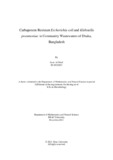Carbapenem resistant Escherichia coli and Klebsiella pneumoniae in community wastewaters of Dhaka, Bangladesh

View/
Date
2021-12Publisher
Brac UniversityAuthor
Shafi, Sazid AlMetadata
Show full item recordAbstract
Background: Carbapenems are beta-lactams that include some of the most widely used antibiotics worldwide, with inhibition of its treatment posing an alarming risk to healthcare. Resistance to this drug is determined by the production of beta-lactamases which are encoded by genes such as NDM-1, IMP, VIM, OXA-48 etc. The detection of such carbapenem resistant bacterial species has been observed in both hospital and community wastewaters of Dhaka, Bangladesh. As microorganisms from sewage can find its way to drinking water, the spread of these microorganisms into community wastewater lines creates the possibility of infections that are challenging to treat. As such, this study was conducted on community wastewater samples to thoroughly monitor and determine the distribution of carbapenem-resistant bacteria in different community regions at differing distances.
Materials and Methods: Wastewater samples were collected from 8 sites in Dhaka and transferred to the laboratory. Bacterial cultures were grown on selective agar media for isolation of Escherichia coli and Klebsiella pneumoniae colonies. Antibiotic resistance profiles of colonies were determined with Kirby-Bauer disc diffusion testing with PCR identification of beta-lactamase genes.
Results: From this study it can be perceived that, 48.84% K. pneumoniae which were either imipenem or meropenem resistant or both of antibiotic resistant, most of them carried the blaNDM gene which is the most common gene responsible for coding the carbapenemase enzyme known as metallo beta-lactamase that makes bacteria resistant to a broad range of beta-lactam antibiotics. But, even though the prevalence of carbapenem resistant E. coli is higher (51.16%), blaNDM gene carriers were less in comparison to K. pneumoniae.
